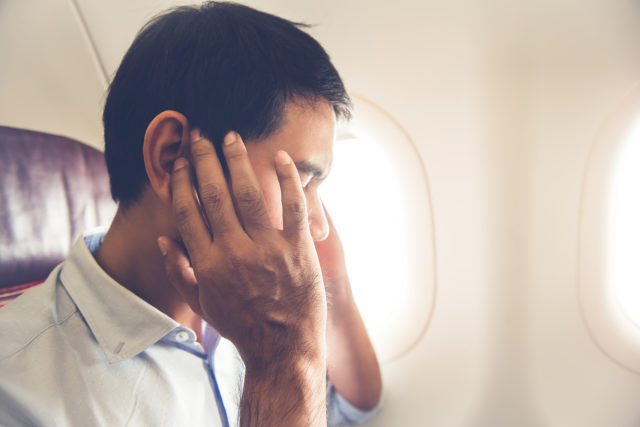Ever have problems with pressure in the ears on a plane flight or during a cold? Blame it on your eustachian tubes.
From Function…
Named for the 16th century anatomist, Bartolomeo Eustachius, the eustachian tubes (ETs) are paired, mucosa-lined structures that connect the back of the nose (nasopharynx) to each middle ear space. Their function is to maintain the pressure in the middle ear spaces equal to atmospheric pressure so that sound waves can move the eardrums (tympanic membranes) in-and-out without a competing pressure differential, thus allowing us to hear. This pressure regulation is achieved by a coordinated effort from several small muscles that attach to the tubes, which are activated by swallowing and yawning. If the eustachian tubes are functioning normally, we are unaware of their existence.
…To Dysfunction
The rapid pressure changes that occur when we ascend or descend in an airplane can overcome the physiologic capacity of the eustachian tubes. On ascent, the atmospheric pressure drops drastically. If the ETs do not react fast enough as a valve to relieve the excess pressure in the middle ear space (relative to the new atmospheric pressure) the thin, sensitive eardrums are stretched (similar to a balloon being blown-up), causing pain. A similar, but inverse phenomenon occurs on the descent. The ambient pressure rises rapidly, causing a negative pressure differential (essentially a vacuum) in the middle ear space. Instead of ballooning the eardrums outward, this negative pressure pulls them inward, again causing stimulation of the eardrum pain receptors. Sometimes, the negative pressure is so severe that it actually causes fluid and/or blood from the tissues of the middle ear space to leak, leading to a condition known as “barotrauma.” In the worst cases, it can even lead to spontaneous rupture of the eardrum. Fortunately, most cases of barotrauma heal fully in time without residual damage.
A negative pressure differential can also develop during a cold, albeit much more gradually. In this case intrinsic, rather than extrinsic, factors are the cause. Inflammation of the eustachian tube lining causes blockage of the tube. If this blockage persists, fluid can be pulled out of the middle ear mucosa by the negative pressure. Children are more prone to this due to immaturity of their ETs. And, when coupled with greater germ exposure and a developing immune system, recurrent ear infections are common in infants and toddlers.
What to Do?
So what is the solution to our eustachian tube problem? In kids with recurrent ear infections (and sometimes adults, too) ear tubes are inserted to bypass the ETs altogether. The ear tubes sit in the eardrums, equalizing the pressure between the atmosphere and middle ear space without relying on the ETs to do the job. If the eustachian tube dysfunction is more transient, say from a plane flight or recent cold, medications such as intranasal and oral decongestants and steroids may be used to address the inflammation within the ETs. “Popping” the ears—forcing air through the ETs from the back of the nose by blowing with the nose and mouth closed—can also help.
More recently, a procedure to dilate the ETs using a balloon catheter has been introduced. This is particularly advantageous for scuba divers that have trouble equilibrating their ears at depth, as ear tubes are contraindicated in this population. The procedure involves cannulating the eustachian tube openings in the nasopharynx under direct visualization with a telescope passed through the nose. A small but strong balloon is then inflated within the ETs for two minutes before removal. As the ETs heal from the procedure, the insides remodel such that they are less prone to collapsibility and obstruction. The procedure can be done in-office and will take about 30 minutes with no additional downtime. Results are typically seen in 4-6 weeks.
